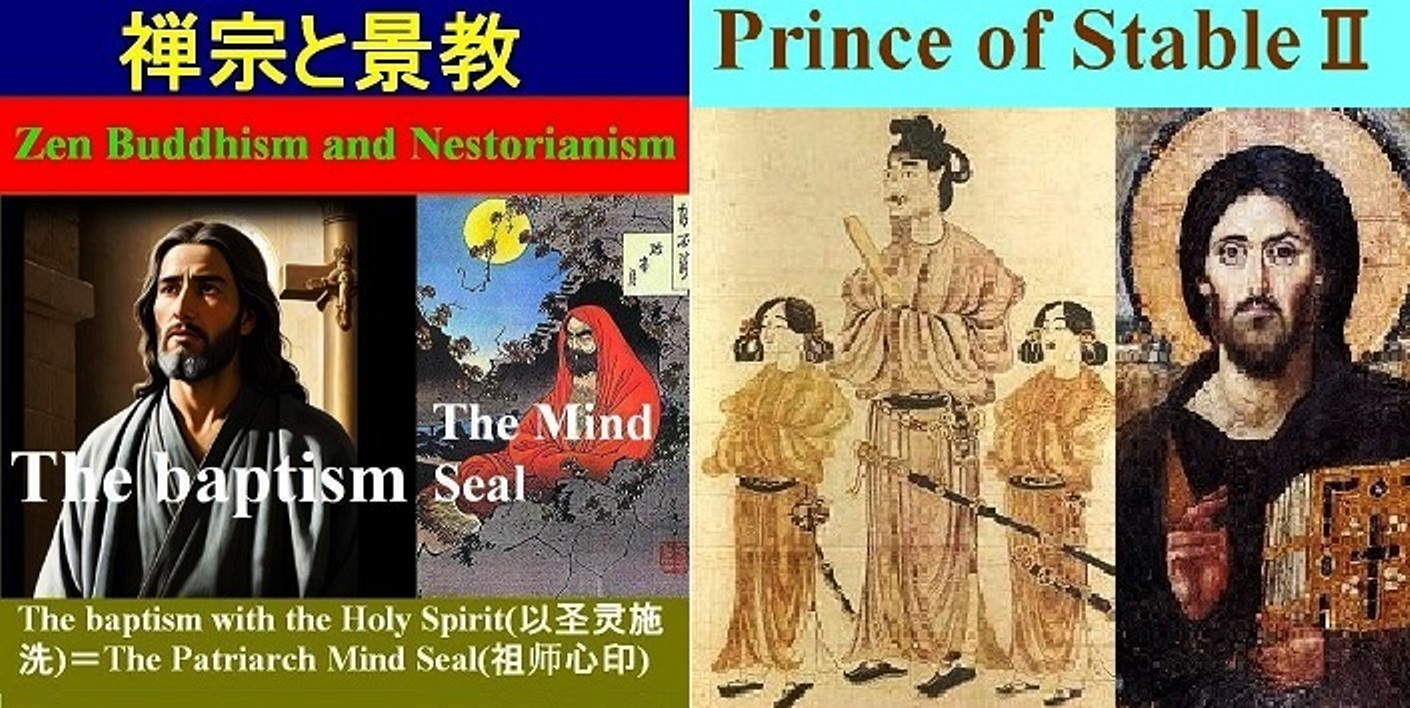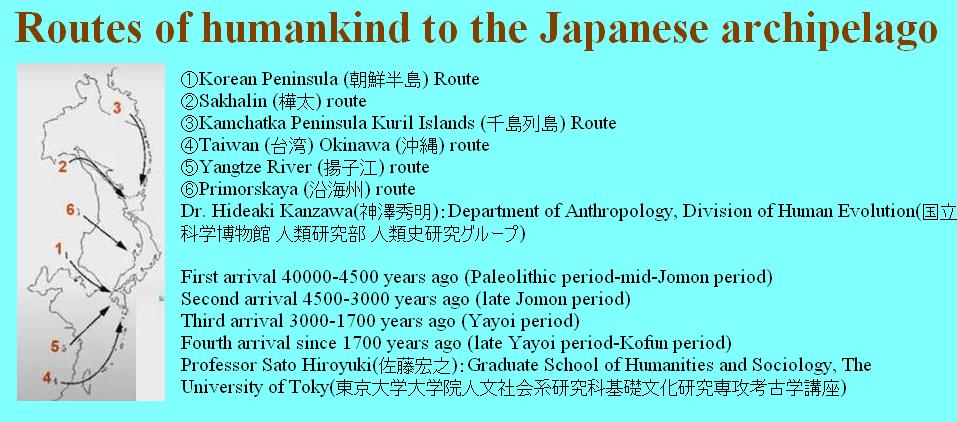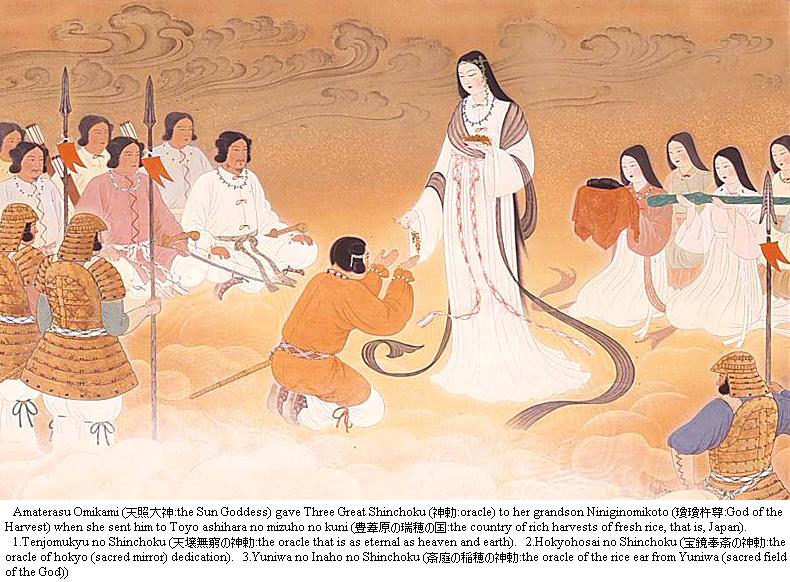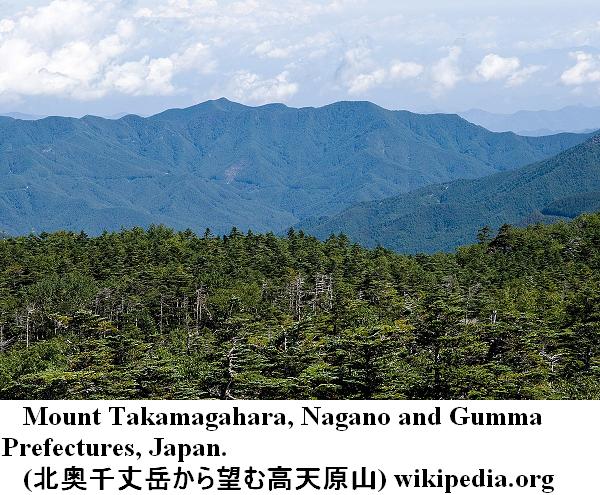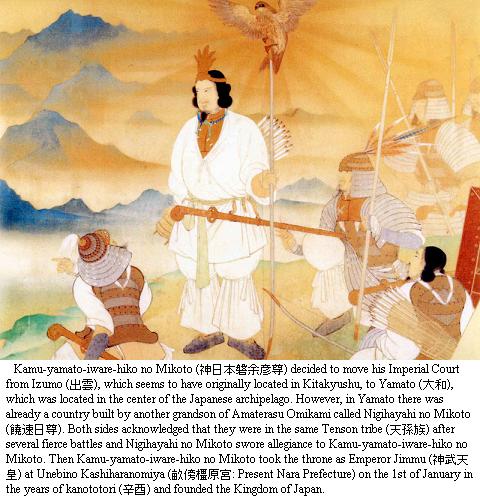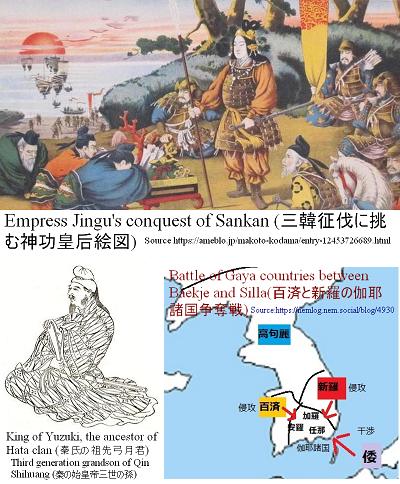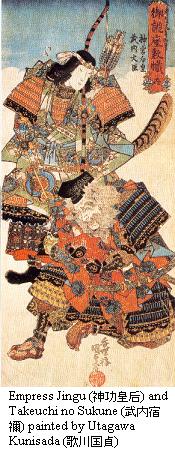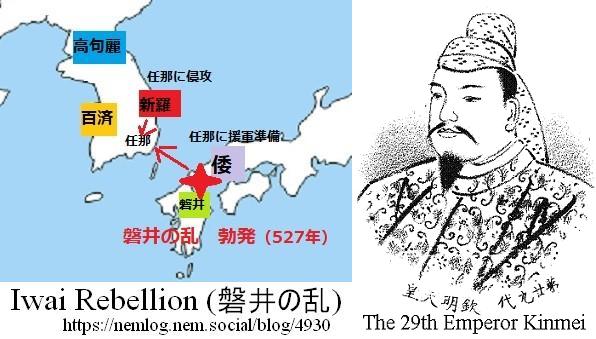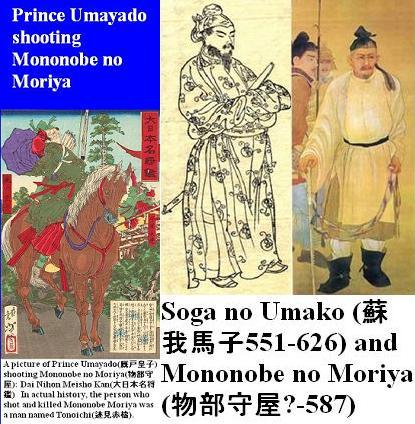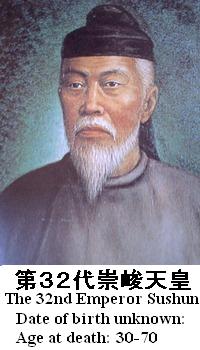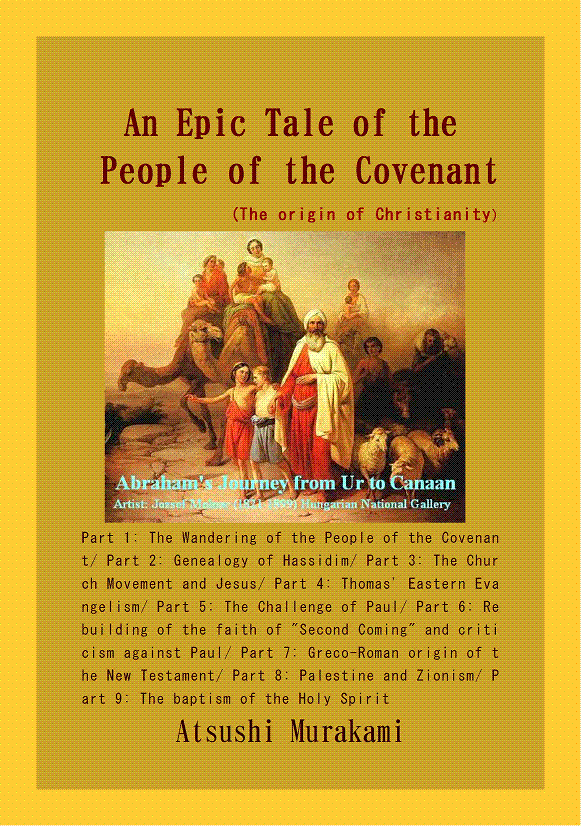The legend of Prince of Stable seems to reflect the different backgrounds of people who migrated to the Japanese archipelago, located at the eastern edge of the Eurasian continent, at different times.
The Jomon culture of the indigenous people of the Japanese archipelago, who possessed the "Y chromosome D2'' gene and migrated to the Japanese archipelago via Sakhalin by around 16,500 years ago, lasted for more than 10 thousand years, and it appears that as early as during this time they had exchanges with the tribes of Ephraim and Manasseh, who possessed the same gene and were counted among the 12 tribes of Judah.
Two versions of the sun goddess's grandson's descent to earth
According to the Kojiki (古事記) and Nihon Shoki (日本書紀), the imperial family of Japan is considered to be a direct line of Ninigi no Mikoto (瓊瓊杵尊), who descended to the peak of Takachiho (高千穂の峰) in Tsukushi (筑紫) of Kitakyushu (北九州) on the order of his grandmother Amaterasu Omikami (天照大神). Amaterasu Omikami, after being handed over Izumo no Kuni (出雲国: State of Izumo) from Okuninushi no Mikoto (大国主命), the son-in-law (or the 6th grandson) of her younger brother Susano no Mikoto (須佐之男命), who had built the state after being exiled from Takamagahara, ordered Ninigi no Mikoto to take care of the state of Izumo.
The great-grandson of Ninigi no Mikoto, Kamu-yamato-iware-hiko no Mikoto (神日本磐余彦尊), that is, Emperor Jimmu decided to move his Imperial Court from Izumo, which seems to have originally located around Tsukushi in Kitakyushu, to Yamato, which was located in the center of the Japanese archipelago. However, in Yamato there was already a country built by another grandson of Amaterasu Omikami called Amaterukuniteruhiko Amenohoakarikushitama Nigihayahi no Mikoto (天照国照彦天火明櫛玉饒速日尊). Both sides acknowledged that they were in the same Tenson tribe after several fierce battles and Nigihayahi no Mikoto swore allegiance to Kamu-yamato-iware-hiko no Mikoto. Then Kamu-yamato-iware-hiko no Mikoto (神日本磐余彦尊) took the throne as Emperor Jimmu (神武天皇) at Unebino Kashiharanomiya (畝傍橿原宮: Present Nara Prefecture) on the 1st of January in the years of kanototori (辛酉), the 11th of February in 660 BC and founded the Kingdom of Japan.
The detail of Nigihayahi no Mikoto's descent from the Heaven has not been reported in Kojiki and Nihonshoki, but according to Sendai Kujihongi (先代旧事本紀: Another ancient Japanese History Book), he was far more attendants than Ninigi no Mikoto was.
Professor Emeritus of Tohoku University, Mr. Hidemichi Tanaka (田中英道1942-), Takamagaharayama in Ueno Village, Tano County, Gunma Prefecture(群馬県多野郡上野村高天原山) seems to be evidence that the cultural sphere of the Jomon people, which corresponds to Takamagahara(高天原) and Hidakami no Kuni(日高見国) described in the Kojiki and Nihon Shoki, existed in the Kanto and Tohoku regions. It is likely that the two versions of myth of the descent of the heavenly grandson reflect the history of the southward migration of the Jomon cultural sphere in the Kanto and Tohoku regions as the climate became colder, and the northward movement of the Yayoi cultural sphere, who had migrated to the south.
Emperor Jimmu's Korean roots and Izumo Taisha Shrine
By the way, Nihon Shoki describes Emperor Jimmu's elder brother Inaino Mikoto (稲飯命) as Silla (新羅) Kings' ancestor. In other words, it implies that a Kitakyushu based Korean Peninsula-linked clan merged the Yamato dynasty founded by Tenson tribe Nigihayahi no Mikoto (天孫饒速日尊) and built the Jimmu dynasty (神武王朝).
Incidentally, the two emperors, who is thought as the founder of Yamato dynasty, appear in Kojiki and Nihonshoki. They are the first Emperor Jimmu (神武天皇) and the tenth Emperor Sujin (崇神天皇). The name of Emperor Jimmu in the Kojiki is 'Kamuyamato Iwarehikonomikoto (神日本磐余彦尊: God of Japan named Iwarehiko),' but in the Nihon Shoki it is described as 'Hatsukunishirasu Sumeramikoto (始馭天下之天皇: Emperor who first ruled Japan).' And regarding the Emperor Sujin (崇神天皇), the Kojiki also states "Hatsukuni Shirashi Mimakino Smelamikoto(初国知らしし御真木天皇)" and the Nihon Shoki states "Hatsukuni Shirasu Smelamikoto (御肇国天皇)," both of which are supposed to mean the first Emperors to rule the nation.
Today, from the second Emperor Suizei (綏靖) to the ninth Emperor Kaika (開化) in the history of ancient Japan, is called "Kesshi hachidai(欠史八代: Eight generations without a description of the achievement)," because there are only genealogies and their personal histories are unclear. However, the genealogy from the 2nd to the 9th may reflect the genealogy of the Yamato Imperial Court before the Jinmu Tosei (神武東征: Emperor Jimmu's expedition to the east), which was founded by Nigihayahi no Mikoto (饒速日尊).
In addition, the 10th Emperor Sujin is said that he suppressed the epidemic by deifying Omononushi no Mikoto (大物主尊: the deity of Izumo Taisha Shrine), and issued the Imperial edict of "Bansei Ikkei (万世一系: an unbroken line of Emperors)."
The conquest of Sankan and Emperor Ojin
It is said that Empress Jingu (神功皇后) executed the the conquest of Sankan (ancient three Korean countries) despite she was already pregnant with her son after the death of Emperor Chuai (仲哀天皇) and produced the son named Hondawakenomikoto (譽田尊) who became the 15th Emperor Ojin (第十五代応神天皇). It is also questioned that he actually existed. Some ones say that he is the same person as the 16th Emperor Nintoku (第十六代仁徳天皇) and others say that he is a fictional emperor in order to add the 26th Emperor Keitai (第二十六代継体天皇) to the genealogy of the Emperor family.
However, in the Emperor Ojin (AD200-AD310)'s reign, scholars and skilled people frequently came in addition to the missions from Baekje and Silla. Especially, in 14th year of his reign, King of Yuzuki (弓月君), who is said to have been the third generation grandson of Qin Shi Huang (秦始皇帝BC259-BC210) and also the ancestor of Hata clan (秦氏), led the people of 120 prefectures and requested naturalization. However, they were stuck in Kala (加羅) after being disturbed by Silla (新羅). Therefore, it is said that Emperor Ojin sent troops to Korean Peninsula twice to realize the arrival of the Yuzuki people.
This dynasty starting from Emperor Ojin was called the "Kawachi dynasty (河内王朝)" because many palaces and mausoleums were built in Kawachi (Present eastern part of Osaka prefecture).
Mr. Koichirou Taneda (種田光一朗), former director of International foundation for the development of culture (国際文化振興財団), pointed out, "Looking at the genealogy of Japanese Emperor's family, the word 'kami (神)' is used in following three Emperors' name, the first Emperor Jinmu (神武天皇), the 10th Emperor Sujin (崇神天皇) and the 15th Emperor Ojin (応神天皇). It seems that when new blood enters the Emperor's family, the letter, 'Kami (神God) = Koin(光胤the seed of the Holy Spirit)' was used."
According to the Nihon Shoki, the 11th Emperor Suinin(垂仁天皇) when he sent back Prince Tsunugaarashito (都怒我阿羅斯等), the prince of Daikayakoku (大伽耶国), who had come from Korean Peninsula, asked him to name his country 'Mimaki (御間城)' useing part of his father Emperor Sujin (崇神天皇)'s posthumous name (諱) 'Mimakiiribikoinienosumeramikoto (御間城入彦五十瓊殖天皇).' This is said to be the origin of Mimana (任那), which later became Japan's prefecture on the Korean Peninsula. "Mimana (任那)" was another name for "Kinkankoku (金官国)," which is one of the small countries called "Kaya (伽耶)" in the southern part of the Korean Peninsula.
For this reason, Honorary professor Namio Egami (江上波夫1906-2002) of the University of Tokyo proposed the theory of northern equestrian people's conquest Japan who came through Mimana (任那) of the Korean Peninsula. And he said that Emperor Sujin (崇神天皇)'s posthumous name (諱)' is the proof that he came from Mimana (任那). In any case, Kojiki (古事記) and Nihonshoki (本書紀) repeatedly imply that the roots of the imperial family of Japan are on the Korean Peninsula.
Soga clan's rise and Takeuchi no Sukune's involvement
By the way, Mr. Biten Yasumoto(安本美典1934-), a psychologist and researcher of Japanese history, says that Emperor Ojin (応神天皇) seems to have been an illegitimate child between Empress Jingu (神功皇后) and Takeuchi no Sukune (武内宿禰), and if so, he said that he could explain well the subsequent rise of Katsuragi clan (葛城氏) and Soga clan (蘇我氏), the descendants of Takeuchi no Sukune.
Takeuchino Sukune (武内宿禰), great-grandson of the 8th Emperor Kogen (孝元天皇), served emperors for five consecutive generations such as Emperor Keiko(景行), Emperor Seimu (成務), Emperor Chuai (仲哀), Emperor Ojin (応神) and Emperor Nintoku (仁徳) as Ohomi (大臣: finance minister) with both ritual and military powers. Ishikawa Maro (石川麿), the grandson of Takeuchino Sukune, was given his surname Soga (蘇我) during the days of Emperor Yuryaku (雄略天皇) and was called Sogano Ishikawano Shukune (蘇我石川宿禰).
Soganomachi (蘇我満智), the second generation of the clan, participated in the politics of Yamato Imperial Court together with Monobenoikofutsu (物部伊莒弗), Hegurinotsuku (平群木菟) and Tsuburanoohomi (円大使主) when the 17th Emperor Ricchu (履中天皇) moved to Iwae (磐余) in the second year of his reign. However, because he had no heir, he adopted the grandson of Prince Rinsho (林聖太子), who had come from Baekje as a hostage. This is Soga Karako (蘇我韓子), who is said to have been active in the palace as the No. 1 official from the Korean Peninsula.
According to Professor Tanaka Hidemichi, "Soga" means "I am resurrected," and this tells us that the Soga clan were Nestorians who professed faith in the "resurrection of Jesus."
Emperor Keitai belongs to Hata clan
The 25th Emperor Buretsu (武烈天皇) died without appointing his successor, so the group members such as Omuraji (大連: Military Minister) Otomo Kanemura (大伴金村) and Monobe Arakabi (物部麁鹿火) and Oomi (大臣: Finance Minister) Kosenoohito (巨勢男人), etc. singled out the clan of Echizen (越前 Hokuriku region centered on present Fukui prefecture) Ohotonoou (男大迹王), who was said to be the grandchild of the fifth generation of Emperor Ojin (応神天皇), as the next emperor. After the twists and turns, Ohotonoou (男大迹王) was crowned as Emperor Keitai (継体天皇), the 26th Emperor, at Kusuba no Miya(樟葉宮) of Kawachi district (河内国) in 507. However, he did not enter Yamato for a long time, and after 19 years, he established the palace in Yamato for the first time at 526. For this reason, there are historians who see Emperor Keitai as the founder of a separate dynasty that did not have blood relationship with the former Yamato Imperial Court and call the dynasty the Echizen dynasty (越前王朝).
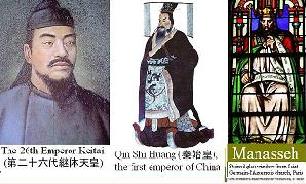
Emperor Keitai married Princess Tashirakanohimemiko (手白香皇女), the daughter of the twenty-fourth Emperor Ninken (仁賢天皇) and assume their son Prince Amekunioshiharakihironiwanomikoto (天国排開広庭尊= Emperor Kinmei) as the legitimate first son. He also married Menokohime (目子媛), the daughter of Owarinomurajikusaka (尾張連草香) and got another two sons called Magarinoohenomiko (勾大兄皇子= Emperor Ankan) and Hinokumanotakataminomiko (檜隈高田皇子= Emperor Senkan).
Kojiki and Nihonshoki do not mention the children of Emperor Ankan (安閑天皇), but according to the book Honchokouinjohunroku (本朝皇胤紹運録), which was compiled in the early days of Muromachi era (室町時代), Emperor Ankan had a prince called Toyohikomiko (豊彦王), and Toyohikomiko and Hata Kawakatsu (秦河勝) were the same person. If this is the case, then Emperor Keitai would also be a member of the Hata clan, who came from Korea and who is said to be a descendant of the first Emperor of Qin. Furthermore, it is possible that Qin Shi Huang (BC259-BC210) itself was a descendant of the tribe of Manasseh, Aramaic-speaking herders.
Iwai Rebellion and Emperor Khinmei's coup theory
One year after Emperor Keitai moved its palace to Yamato, Baekje which had invaded by Silla, asked him to rescue. Emperor Keitai tried to send an expeditionary force to Korean Peninsula, but Iwai (磐井), a clan of Tsukushi in Kitakyushu, revolted joining hands with Silla. By suppressing this rebellion, Emperor Keitai is said to have solidified the foundation of his reign.
In addition, Nihonshoki cites the description of 'Kudara Honki (百済本記: Original Records of Baekje)' that "the Emperor and the Crown Prince and the Prince died at the same time in the year of KanotoI (辛亥)", and suggests that a coup d'etat occurred in the later years of Emperor Keitai. As a result, the following theory was born, "The Emperor Keitai and his original successors, Ankan and Senka, were murdered and Emperor Kinmei took the throne."
Teibinoran war
According to the 'Nihon Shoki, in 552 C.E., Baekje (百済) King Song Myong (聖明王), presented a letter to Emperor Kinmei (欽明天皇) along with a bronze statue of Buddha and Buddhist scriptures and encouraged to promote Buddhism in Japan.
Emperor Kinmei asked the ministers how to handle the Baekje's proposal. Mononobe clan (物部氏) and Nakaomi clan (中臣氏), who had been in charge of Shinto (神道) ritual of the Yamato court (大和朝廷), opposed, but Soga clan (蘇我氏), who had had a close relationship with foreign settlers and the Korean Peninsula, supported the promotion of Buddhism. Emperor Kinmei abandoned himself to believing in Buddhism after splitting the opinion of the ministers in the Imperial Court and gave the Buddha statue to Soga Iname (蘇我稲目) and allowed him to privately worship and build temples. However, this led to overheating of power struggle in the court between Monobe Clan, who was in charge of Shintoism, and Soga Clan, who was eager to promote Buddhism.
After Emperor Yomei (用明天皇)'s death, Soga Umako (蘇我馬子) and Monobe Moriya (物部守屋) having two princes of Emperor Kinmei, Prince Hatsusebe (泊瀬部皇子) and Prince Anahobe (穴穂部皇子), respectively for the next emperor and had an armed clash. Then so-called Teibinoran (丁未の乱) occurred. The battle ended in a victory for Soga Clan, Prince Hatsusebe was enthroned as Emperor Sushun (崇峻天皇), and Monobe Clan was wiped out of court.
The murder of Emperor Sushun
Emperor Sushun(崇峻天皇) had a son, Prince Hachinoko, with Otomo no Nukateko(大伴糠手子)'s daughter, Otomo no Kotekko(大伴小手子). However, if Prince Hachinoko had succeeded to the throne, the Soga clan would no longer be able to secure their position as maternal relatives, and there was a possibility that the direct line of the royal family would pass to the Sushun line.
Emperor Sushun personally proposed the restoration of Mimana in 591, marched over 20,000 soldiers to Tsukushi, and dispatched envoys to censure Silla. However, this may have caused friction between the emperor and the Soga clan over diplomacy.
In October of the 5th year of the reign of Emperor Sushun (592), when a boar was presented to the Emperor, Emperor Sushun remarked, "Someday, I would like to cut off the head of someone I hate, just as I cut off the head of a boar." Upon hearing this, Umako, on the pretense of receiving tribute from the eastern provinces, had Yamato no Aya no Koma(東漢駒) assassinate Emperor Sushun that same year.
<To be continued>
What is "Baptism with The Holy Spirit"?
According to the dialectic of the Gospel of John,
【Thesis】
"A man can possess eternal life through accepting testimony of the Son of man and being baptized by him." (John 5:24)
【Anti-thesis】
But "The one who comes from the earth cannot accept the testimony by one from heaven." (John 3:32)
How then can a man possess eternal life?
【Synthesis】
"If you want to be baptized with the Holy Spirit, you can just go back to the word which was with God in the beginning (John 1:1) and certify that God is truthful. (John 3:33)"
When he said, "You are Huichao," Zen Master Fayan thrusted vivid Self in Huichao in front of his eyes.
Purchase here
○One world:
Your Comments / Unsubscribe
SEAnews Messenger
SEAnewsFacebook
SEAnews eBookstore
SEAnews world circulation
